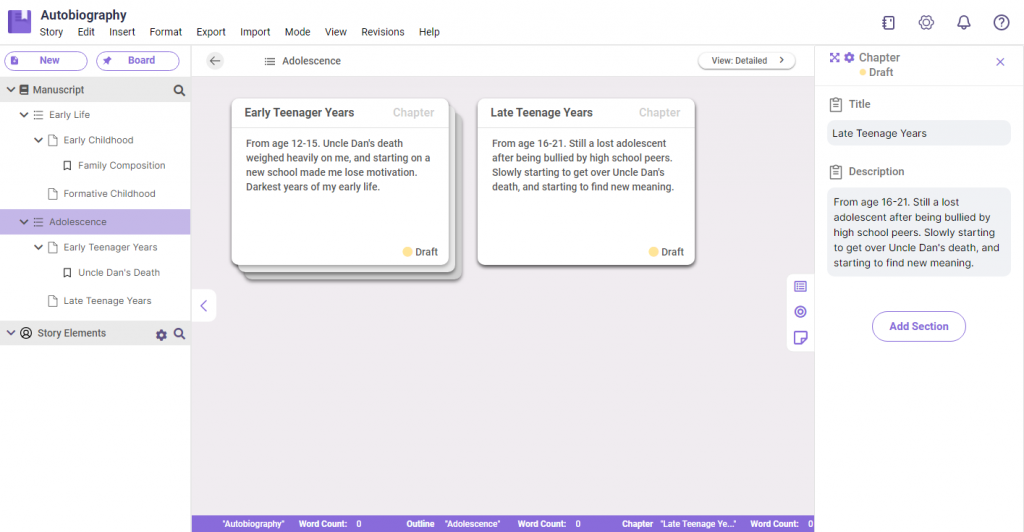How to Write An Autobiography with LivingWriter

We’ve been there: making English assignments where we tell more about ourselves and the lives we’ve lived until now. They just seemed to be nothing more than just a writing exercise, but autobiographies are one of the more popular pieces of nonfiction writing.

Autobiographies offer an intimate perspective of the life of a person and people are keen on learning more about others. Fueled by this discovery, you might be tempted to write an autobiography of yourself right now. It’s a book about you, how hard could it be?
Turns out, it can be hard. Writing about your life has its own set of challenges that are specific to autobiography writing, so we’re here to sort those out for you! We’ll also give you tips on how LivingWriter can help you write the next bestseller autobiography in the nonfiction category.
Autobiography vs. Similar Pieces
First off, you might want to differentiate an autobiography from other similar genres. Biographies are similar to autobiographies in that they are stories about the entire life of a person, but biographies are written by someone that’s not the subject.

Another similar piece, memoirs are the same as autobiographies in the sense that they are both written by the subject themselves. However, memoirs tend to fixate on a specific event or era of a person’s life, while autobiographies cover the entirety of the subject’s life, from birth to the time of writing.
You have to understand that an autobiography will talk about your entire life. Give or take a few uninteresting years, this piece will want to explore your life from start to present. This can make the process of how to write an autobiography hard, but it’s not totally impossible. Others have done it, and you should be able to, too!
Tips on Writing an Autobiography
Now that we’ve got the technical nuances away, it’s time to delve into the process of writing an autobiography!
Brainstorm Your Ideas
It can be hard enough to remember where you placed your phone a few moments ago, so recalling your entire life understandably occupies the entire first step in writing your life story. This step is not yet the outlining step, but rather just the general collection of ideas from your life.

During this time, you might want to take a good seat and think back on your life. Write down notable events and achievements, successes and failures, relationships and fallouts, and other major events in your life.
You can either start from the top, recalling memories from your childhood up to the current point of your life, or backtrack from the present and list down recent happenings until you reach your babyhood. As much as you would love a chronologically ordered list, it is not necessary at this point. What’s important is to get down as many ideas as you can; many will not make the cut in your manuscript, but having a lot to work with will help you in the outlining phase.
Research About Yourself

It can feel a bit odd to say that you will need to research about yourself, but times like your childhood may not retain as many memories in your mind as you’d like. Your best source of material for these periods in time would be your immediate family, like your parents and siblings.
Additionally, researching about yourself also entails clarifying muddy details about past events. There might be things you have missed about a memory, so you would want to consult your friends and peers to learn more about that memory.

More importantly, asking other people about you can give you another perspective about yourself, especially during the past. Insights from other people can help you reflect on that event, and these insights can be helpful as you write an autobiography.
Some people may even go further and research the social and cultural contexts of their birth or other significant events in their lives. This can help enrich your narrative and build upon not just the life you led but the environment you lived in.
Make an Outline
Now that you have a list of ideas, you will want them organized. You might think that writing an outline for your own life story is silly; what use is an outline for a nonfiction piece where the only hard requirement is chronology? Well, that’s where you thought wrong.
An autobiography is more than just an ordered sequence of events from your birth to the time of writing; it is a narrative story of how you lived your life until now. As a story, it will still have a semblance of a plot, with an introduction, a few highs and lows, sometimes the denouement of arcs.
Writing an autobiography is not very far from writing a story: more than anything it is the closest to writing stories, as it is the narration of a story that you yourself have lived through as the main protagonist.

With that said, one important aspect of writing an outline is to determine the overarching themes that you would want to emphasize in your life. Knowing which theme to pursue will help you prune some of the ideas that you have, and align your life story to a loose ‘plot.’ This makes your story a bit more interesting, and ultimately tells the reader what they can expect to gain from reading about your life.
This phase can be an introspective time for you as a person; identifying key concepts in your life might need you to have some time for reflection. What lessons do you want to impart to other people from learning about you? What have you learned throughout your life that has made you who you are right now?

Don’t rush this part of the process, as this can be the most crucial step. Take your sweet time reflecting on your life, and create the outline that your life story deserves.
Of course, if you are in need of robust outlining tools, look no further than LivingWriter. LivingWriter sports the Board, where you can access the Chapters and Outlines. You can create basic outlines and have them visible on the Board akin to index cards in a corkboard. With four levels of hierarchy, you can go as detailed with your outline as you want with LivingWriter.

Additionally, the notes system in LivingWriter’s outlining tools is the most comprehensive, allowing you to store not only short descriptions but extra space for other specific notes for that chapter or subchapter. Plus, these notes are readily available whenever you write your manuscript, so you don’t have to flip over your pile of papers to look for that specific memory you wanted to talk about in that chapter. Just take a look at your right sidebar and you will have everything you need.
The Actual Writing
Now that you have an outline, it’s time to start writing! There are no specific rules for writing an autobiography, but you will still need to follow basic grammar and verb tense rules. For the majority of the autobiography, you would be talking in past tenses, given that you are recalling past experiences. Later on, you can opt for the present tense when you are nearing the current point of your life, and even venture on the future tense if you are detailing your future plans.
As with any first draft, you don’t have to expect a great piece right off the bat. You can expect a lot of errors and mistakes to be fixed, but you need to finish a manuscript first before you can get to polishing it.
Take Some Time Off

For self-editing authors, taking some time off after writing any piece can be a given. However, letting go of your first draft for a time after finishing it is even more important for autobiographies. The incredibly personal nature of this work can make for a biased perspective when you are going for the first edit. Hence, you should take a break from the autobiography so that you can revise it with a fresher look.
Revise, Write, then Rinse and Repeat
Manuscripts are built upon the mountains of revisions and critiques, and autobiographies are no different. The process of writing is the same: revise and rewrite over and over again. Over time, you will reach a point where you can say that your manuscript is ready for the world. And that’s when you are done!
Write an Autobiography with LivingWriter Today
Autobiographies can be very personal works, but writing them is not that much different, or any easier than other pieces of literature. If you believe that your life is worth sharing with other people, that they may learn a lesson in life by learning about your life, then, by all means, go ahead and write an autobiography. Don’t forget to use LivingWriter and see how the greatest writing companion can help you tell your life story better!